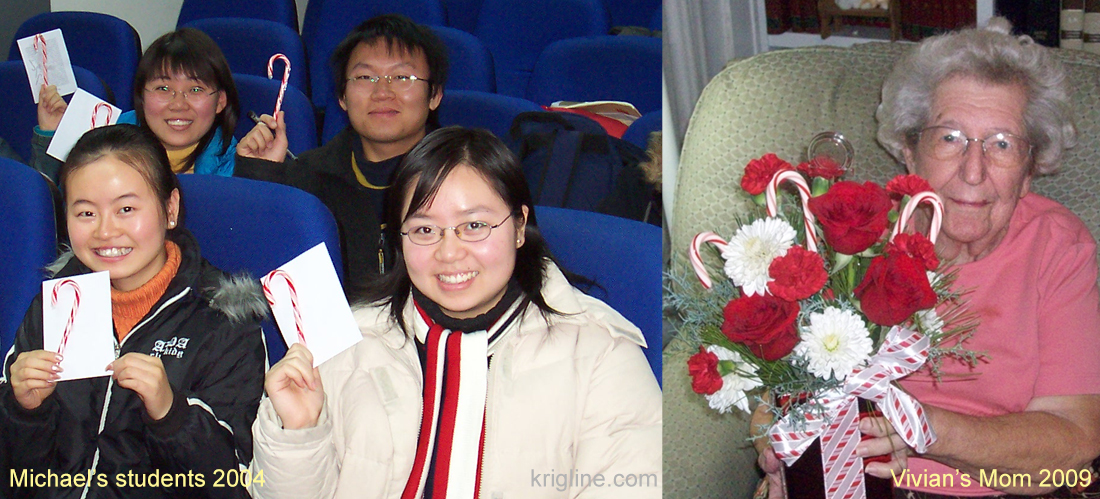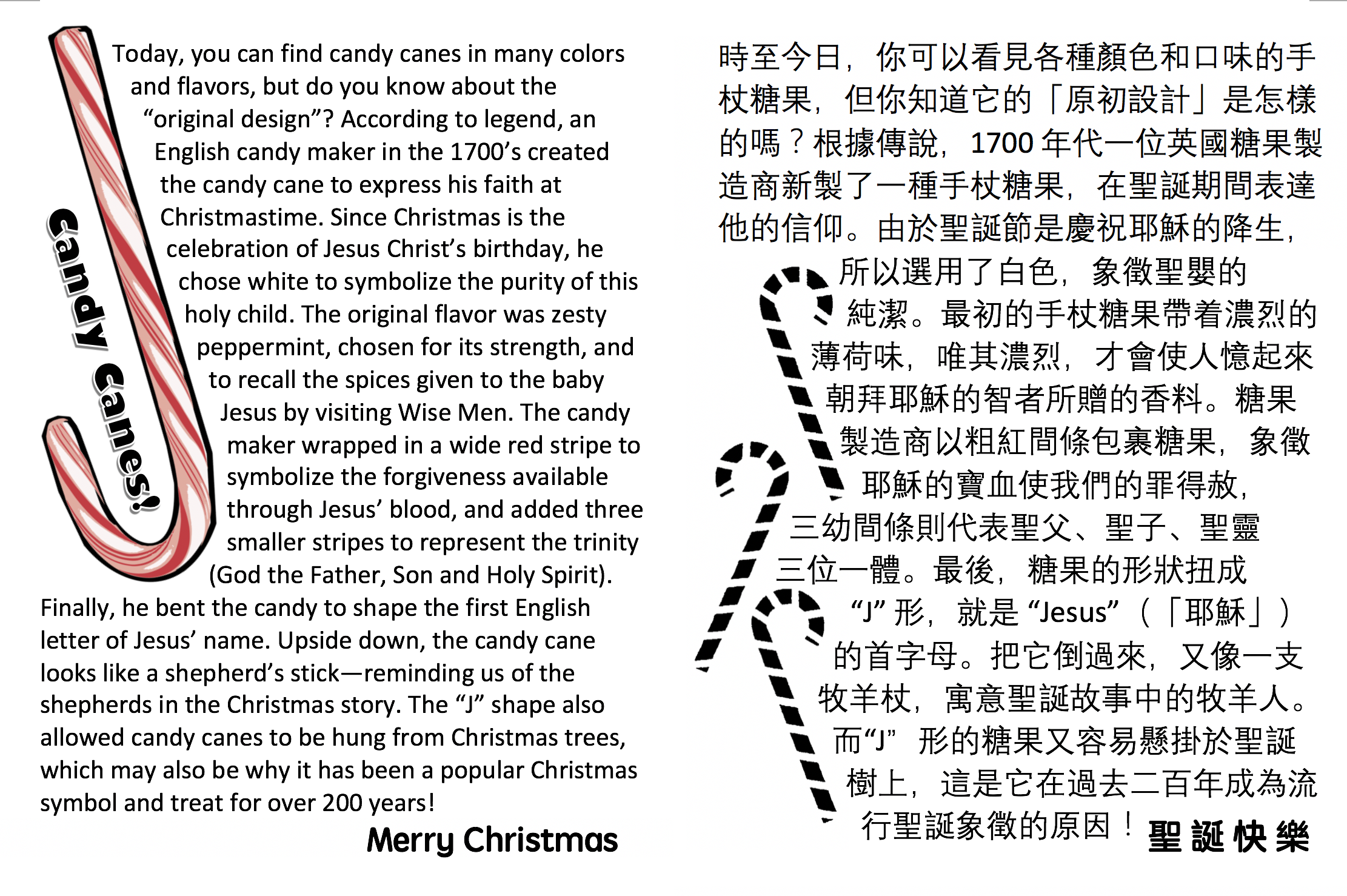Christmas Candy Canes
©Michael Krigline, MA (2015), EFLsuccess.com⇔
A brief introduction to Christmas Candy Canes (拐杖糖)⇔
(See vocabulary, notes, and discussion questions below)
Perhaps you’ve seen candy canes hanging on a Christmas tree, or used as a Christmas decoration. This tasty treat has an interesting history.
According to one legend, an English candy maker in the 1700’s created the candy cane to express his faith at Christmastime.
Since Christmas is the celebration of Jesus Christ’s birthday, he chose white to symbolize the purity of this holy child. The original flavor was zesty peppermint, chosen for its strength (a big spoonful flavors 50 kg of candy!), and to recall the spices given to the baby Jesus by visiting Wise Men. The candy maker wrapped a wide red stripe into his creation to represent the sacrifice of Christ (whose “blood” made forgiveness and a relationship with God possible). Next, he added three smaller stripes to represent the Trinity (God the Father, Son and Holy Spirit). Finally, he bent the candy to shape the first letter of Jesus’ name. Upside down, the candy cane looks like a shepherd’s “crook” (or stick)—reminding us of both the shepherds in the Christmas story and of Jesus, the “Good Shepherd.” The “J” shape also allowed candy canes to be hung from Christmas trees, which may also be why it has been a popular Christmas symbol and treat for over 200 years!
Today, you can find candy canes in many colors and flavors, but my favorite will always be the “original design,” which is not only delicious, but also reminds me of the unique and enduring way that a common candy-maker expressed his faith at Christmastime.

Peppermint as an “essential oil.” Peppermint is a cross between spearmint and watermint. It has a sharp smell that is cool and refreshing. Peppermint candy is known for its cooling flavor. As an “essential oil,” some believe that smelling peppermint can help relieve headaches, the common cold, or an upset stomach. (Important note: While using “essential oils” is popular, the US government does not monitor, regulate, or support their affects on health; use with caution!)
Vocabulary
(terms in either the article above or extras below; *key terms) sth = something; sb = somebody.
- bent: past tense of “bend”; crooked or twisted
- hung: past tense of “hang.” E.g.: “In some countries, Christmas socks are hung by the chimney, in hope of getting small gifts.”
- *legend: an old, well-known story (or person), often presented as “true/historical” even though this may not be completely accurate
- *original: in the beginning; before many copies
- *sacrifice: valuable things you give up (e.g., your desires, safety, or even your own life) in order to help others (such as the choice to teach poor children for less money than you would make at a “rich” school). Examples: “In the Narnia stories, Aslan sacrificed his life to pay for Edmund’s treachery, believing that the result would be better for Narnia in the end.” “In many cultures, people sacrifice their animals to ‘pay’ for the forgiveness of their sin, and thus show God that they understand how valuable forgiveness is.”
- treat: sth good that you expect the receiver to enjoy
- zest/zesty: thought of as exciting and interesting; food that is strong yet pleasing to the sense of taste
Discussion
- If the article has any words you don’t know, ask your teacher about them.
- Talk about what the colors of a candy cane represent, according to the article.
- Think about other symbols you know of (for example: a flag, or a wedding dress)—what do the colors represent?
- Do you have experience using “essential oils”? Tell us why you use them, and if you have ever tried using peppermint (and what happened).
- The article mentioned “wise men” and “shepherds” as part of the historical Christmas origin story. Talk about who these people were, what they gave to the baby Jesus, and why they wanted to find this child. (The teacher may need to look into this before class! See http://wp.krigline.com/christmas/)
- What characteristics of a “shepherd” would be so appealing that a religious teacher like Jesus might call himself “the good shepherd”? (If you need help, see “If you still have time” below.)
- According to the author, creating the candy cane helped a candy-maker express his faith in his profession. Talk about ways that you can appropriately express your faith or “world-view” in your profession.
- The author says that the candy cane is one of his favorite Christmas decorations. Talk about your favorite decoration (or song/tradition) related to this international holiday (or pick another holiday from your culture).
If you still have time: Read and discuss Ezekiel 34:11-16 (Bible, written before 570BC), as he talks about “the good shepherd.” Jesus and his first-century hearers would have been familiar with this ancient text. What does the chapter have to say about both good and bad shepherds? How does God say he is like a good shepherd?

時至今日,你可以看見各種顏色和口味的手杖糖果,但你知道它的「原初設計」是怎樣的嗎?根據傳說,1700年代一位英國糖果製造商新製了一種手杖糖果,在聖誕期間表達他的信仰。由於聖誕節是慶祝耶穌的降生,所以選用了白色,象徵聖嬰的純潔。最初的手杖糖果帶着濃烈的薄荷味,唯其濃烈,才會使人憶起來朝拜耶穌的智者所贈的香料。糖果製造商以粗紅間條包裹糖果,象徵耶穌的寶血使我們的罪得赦,三幼間條則代表聖父、聖子、聖靈三位一體。最後,糖果的形狀扭成“J”形,就是“Jesus”(「耶穌」)的首字母。把它倒過來,又像一支牧羊杖,寓意聖誕故事中的牧羊人。而“J”形的糖果又容易懸掛於聖誕樹上,這是它在過去二百年成為流行聖誕象徵的原因!
When we give out this candy, we like to attach a simple introduction. Two copies can be printed on A4 paper if you use the following file/picture.
PDF file: Candycane A4 bilingual
(For more information about Christmas, see these Christmas pages (underlined topics are on EFLsuccess.com or Krigline.com; others are on our older website): Christmas (international celebration), the song “Silent Night” and Chinese Christmas apples, the traditional Christmas story, who is Santa (圣诞老人)?, candy canes, holiday safety tips, Christmas Perspectives (poem), and the pre-Christmas Advent season. Also look for Christmas wallpaper on our old website. You’ll also find movie study guides on this website (or our old site) for some great holiday films: A Snoopy/Charlie Brown Christmas, Last Holiday, White Christmas, The Grinch, Christmas Carol, It’s a Wonderful Life)
EFLsuccess.com; ©Michael Krigline, all rights reserved. Our resources were created for our students under my understanding of “fair use” for educational resources. As far as I am concerned, website visitors are allowed to print/copy these materials for personal or classroom use. For details, see our Website Standards and Use Policy.
~ ~ ~ ~ ~ ~ advertisement ~ ~ ~ ~ ~ ~


